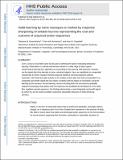Habit Learning by Naive Macaques Is Marked by Response Sharpening of Striatal Neurons Representing the Cost and Outcome of Acquired Action Sequences
Author(s)
Desrochers, Theresa M; Amemori, Ken-ichi; Graybiel, Ann M
Downloadnihms-712866.pdf (2.737Mb)
PUBLISHER_CC
Publisher with Creative Commons License
Creative Commons Attribution
Terms of use
Metadata
Show full item recordAbstract
Over a century of scientific work has focused on defining the factors motivating behavioral learning. Observations in animals and humans trained on a wide range of tasks support reinforcement learning (RL) algorithms as accounting for the learning. Still unknown, however, are the signals that drive learning in naive, untrained subjects. Here, we capitalized on a sequential saccade task in which macaque monkeys acquired repetitive scanning sequences without instruction. We found that spike activity in the caudate nucleus after each trial corresponded to an integrated cost-benefit signal that was highly correlated with the degree of naturalistic untutored learning by the monkeys. Across learning, neurons encoding both cost and outcome gradually acquired increasingly sharp phasic trial-end responses that paralleled the development of the habit-like, repetitive saccade sequences. Our findings demonstrate an integrated cost-benefit signal by which RL and its neural correlates could drive naturalistic behaviors in freely behaving primates. Video Abstract: Feedback about the costs and benefits of our actions is an essential part of how we learn. Desrochers et al. show that neurons in the striatum of monkeys develop combined cost-benefit signals marking movement sequences that they acquire without explicit training.
Date issued
2015-08Department
Massachusetts Institute of Technology. Department of Brain and Cognitive Sciences; McGovern Institute for Brain Research at MITJournal
Neuron
Publisher
Elsevier/Cell Press
Citation
Desrochers, Theresa M. et al. “Habit Learning by Naive Macaques Is Marked by Response Sharpening of Striatal Neurons Representing the Cost and Outcome of Acquired Action Sequences.” Neuron 87, 4 (August 2015): 853–868 © 2015 Elsevier Inc
Version: Author's final manuscript
ISSN
0896-6273
1097-4199